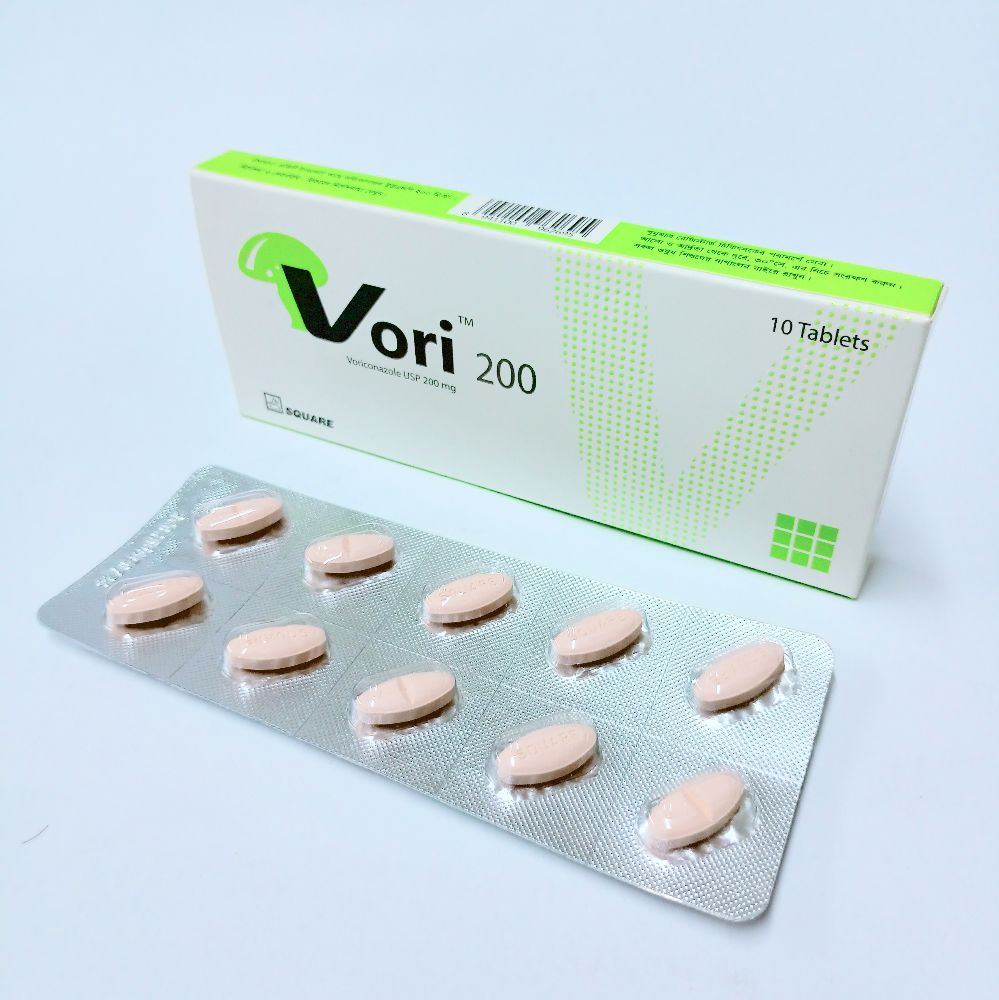
Type:10 Tablets
Generic Name:Voriconazole
Manufacturer:Square Pharmaceuticals PLC.
Price:৳1000.00
Candidemia, Deep tissue Candida infections, Invasive aspergillosis, Scedosporiosis and Fusariosis
Should be taken on an empty stomach. Take at least 1 hr before or after meals. Infuse IV over 1-2 hr, not to exceed 3 mg/kg/hr
Adult Invasive Aspergillosis, Candidemia, Serious Fungal Infections 6 mg/kg IV q12hr for first 24 hours, then 4 mg/kg IV q12hr or 200 mg PO q12hr Esophageal Candidiasis Candida albicans, Candida glabrata, Candida krusei 200 mg PO q12hr Hepatic impairment: Mild to moderate (Child-Pugh category A and B): Standard loading dose but maintenance doses should be reduced by 50%.
<12 years: Safety and efficacy not established Child >12 years Invasive Aspergillosis, Candidemia, Serious Fungal Infections 6 mg/kg IV q12hr for first 24 hours, then 4 mg/kg IV q12hr or 200 mg PO q12hr Esophageal Candidiasis Candida albicans, Candida glabrata, Candida krusei 200 mg PO q12hr
Hypersensitivity. Co-admin w/ CYP3A4 substrates, terfenadine, astemizole, cisapride, pimozide, quinidine, rifampicin, carbamazepine, long-acting barbiturates (e.g. phenobarbital, mephobarbital), ergot alkaloids (e.g. ergotamine and dihydroergotamine), efavirenz (≥400 mg once daily), ritonavir (≥400 mg bid), sirolimus, rifabutin, St John's wort.
Voriconazole is a triazole antifungal agent which inhibits cytochrome P450-dependent enzymes thereby inhibiting ergosterol synthesis in fungal cell membranes. It has a broad spectrum of activity against all Candida spp. including strains resistant to fluconazole), Aspergillus spp., Scedosporium spp., and Fusarium spp.
Patient w/ potentially proarrhythmic conditions, risk for acute pancreatitis. Correct electrolyte disturbances e.g. hypokalaemia, hypomagnesaemia and hypocalcaemia prior to treatment. Hepatic and renal impairment. Pregnancy and lactation. Patient Counselling May impair ability to drive or operate machinery. Avoid intense or prolonged exposure to direct sunlight. Monitoring Parameters Monitor hepatic (prior and during treatment) and renal (during treatment) function, serum electrolytes, visual and pancreatic function. Lactation: Not known if excreted in breast milk, a decision should be made whether to discontinue nursing or drug; weigh risk/benefit
>10% Visual changes (photophobia, color changes, increased or decreased visual acuity, or blurred vision occur in 21%) 1-10% Tachycardia,Hypertension,Hypotension,Vasodilation,Peripheral edema,Fever,Chills,Headache,Hallucinations,Dizziness,Rash,Pruritus,Photosensitizing skin reactions,Hypokalemia,Hypomagnesemia,Nausea,Vomiting,Abdominal pain,Diarrhea,Xerostomia,Thrombocytopenia,Alkaline phosphatase increased,Serum transaminases increased, ALT/AST increased,Cholestatic jaundice,ARF
Increased prothrombin time w/ oral anticoagulants. May increase plasma concentrations of ciclosporin and tacrolimus, long-acting opiates (e.g. oxycodone, methadone), NSAIDs (e.g. ibuprofen, diclofenac), omeprazole, short-acting opiates (e.g. alfentanil, fentanyl). Decreased voriconazole plasma concentration and increased phenytoin plasma concentrations when used concomitantly. May increase plasma concentration w/ oral contraceptives. Potentially Fatal: May increase risk of QT prolongation or torsades de pointes w/ astemizole, cisapride, pimozide, quinidine and terfenadine. May increase risk of ergotism w/ ergot alkaloids (e.g. ergotamine and dihydroergotamine). May significantly increase plasma concentrations of sirolimus. Decreased plasma concentrations w/ rifampicin, carbamazepine, long-acting barbiturates (e.g. phenobarbital, mephobarbital), efavirenz (?400 mg once daily), ritonavir (?400 mg bid). Concomitant use may significantly increase rifabutin and decrease voriconazole plasma concentration.